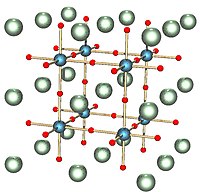
Photo from wikipedia
Abstract Chemical and electronic sensitization in metal oxide gas sensors are severely limited by poor dimension controls of metal oxide nanostructure and their electric/electronic properties. These limitations are overcome using… Click to show full abstract
Abstract Chemical and electronic sensitization in metal oxide gas sensors are severely limited by poor dimension controls of metal oxide nanostructure and their electric/electronic properties. These limitations are overcome using hydrothermal-induced heterointerface engineering approaches. This work demonstrates that forming spherical titanium dioxide nanoparticles on a substrate significantly reduce a surface energy barrier of nucleation and induces novel mesophorous hierarchical TiO2 structure during hydrothermal synthesis, consequently increasing the surface area of the structure by ∼ 3 times compared to that of control. In addition, we succeeded in tailoring the energetics of hierarchical TiO2 nanosctructure by decorating with the nickel oxide and silver nanoparticles, which results in a desirable semiconductors/metal heterointerface for fast charge transfer where silver nanoparticles bridge nickel oxide and TiO2 nanostructure, and silver nanoparticles serve as preferential sites for chemisorption and migration of oxygen anions. The resulting heterostructure sensing properties such as sensitivity, limit of detection and selectivity are studied as a function of operating temperature (30–150 °C), relative humidity (RH) and various volatile organic analytes concentrations. The TiO2/Ag/NiO heterostructure finally exhibits a high gas response of ∼ 2.1 for acetone with a limit of detection of 34 ppb at 30 °C (or 21 ppb at 90 °C), and retains an excellent selectivity of acetone even at 90 % relative humidity. It exhibited a highly stable and speedy gas response for acetone toward various gases such as formaldehyde, ethanol, hydrogen sulfide, carbon monoxide even operating at 90 °C. Our results suggest a potential of constructed TiO2/Ag/NiO heterostructure for superior sensing volatile organic acetone and will also stimulate research on hetero-structured gas sensors with high sensitivity and selectivity.
Journal Title: Chemical Engineering Journal
Year Published: 2022
Link to full text (if available)
Share on Social Media: Sign Up to like & get
recommendations!